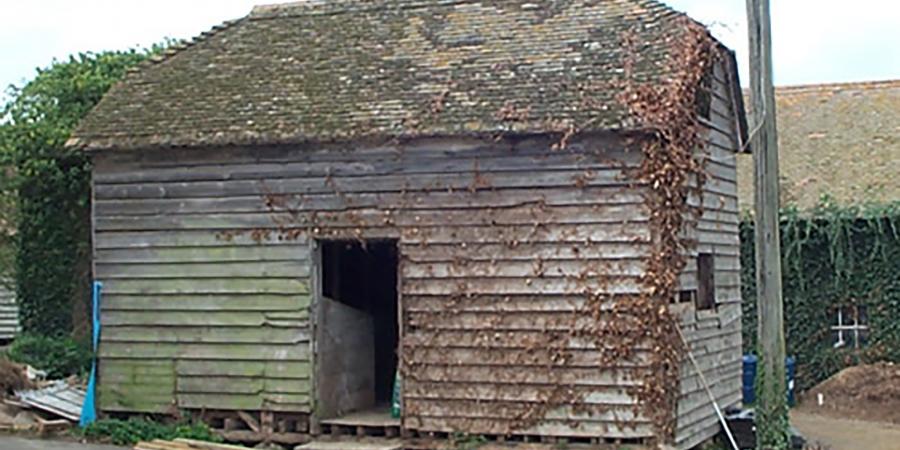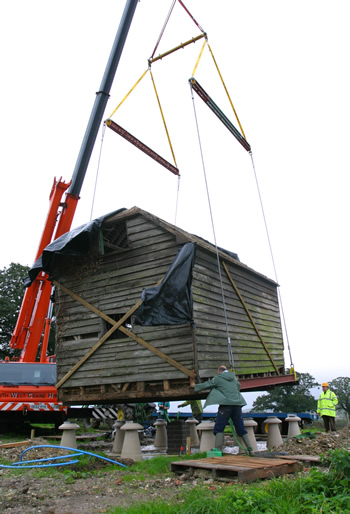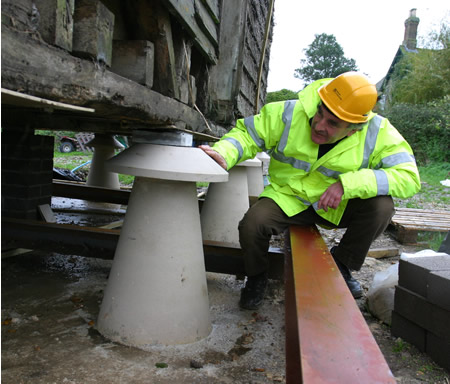Project Background
Vale Farm is located close to the village of Sutton Waldron, in the rolling countryside of the Blackmore Vale. The village and its parish lie 5 miles south of Shaftesbury just to the west of the A350, between Blandford Forum and Shaftesbury.
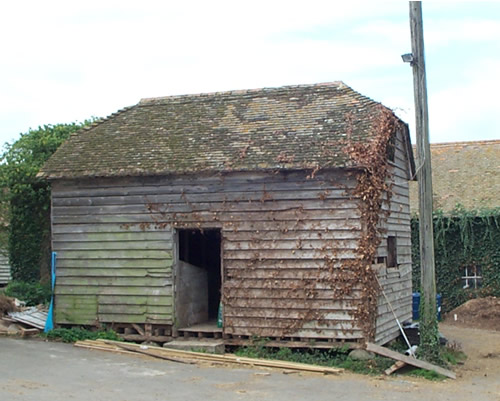
The Conservation Management section of Wessex Archaeology was commissioned to prepare a proposal to save a historic building at Vale Farm, Sutton Waldron. The building is a timber framed, Victorian staddle granary. It sits on large carved stones that resemble mushrooms. The stones are known as staddles. These supported the building above ground level and were shaped to prevent rats entering and eating the stored grain.
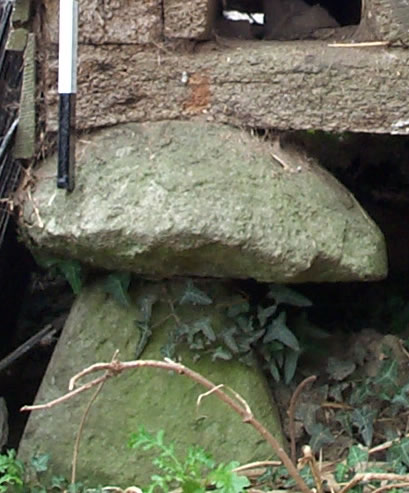
A scheme was devised to convert the granary into a holiday cottage that will compliment others on the farm. Like many other farmers, the owners have diversified by converting several redundant 19th century cattle buildings into holiday accommodation. The granary could not be re-used in its original position. Work entailed a feasability survey for the re-use of the building, designs for the conversion and assistance in gaining planning permission.
Building history
]The granary is one of several Victorian buildings on the farm. The survey produced a detailed set of drawings upon which the conversion was based. It also revealed more than just the condition of the granary. A set of initials and a date carved into one of its ancient timbers were discovered. The inscription reads 'W.E. 1856'. Whilst we may never know who W.E. was, it gives us a window into the building's past.
[img_assist|nid=252|title=The Carved Beam|desc=|link=node|align=left|width=200|height=143
The village of Sutton Waldron is on the edge of Blackmore Vale, the setting for Thomas Hardy’s famous novel Tess of the D’Urbevilles: 'This fertile and sheltered tract of country, in which the fields are never brown and the springs never dry'
Discover more about the history of Sutton Waldron
A brief history of Sutton Waldron
The population at Domesday was 120, in 1811 there were 218 people living in the village and by the time the granary was built in 1856, there were around 257.
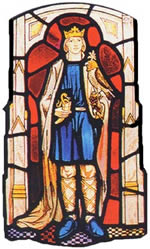
On two occasions this quiet little village has glimpsed events of national importance. The first was in AD980, when the funeral cortege of Edward the Martyr (murdered two years previously at Corfe Castle) passed through on its way from Wareham to Shaftesbury. The second was in 1645, when Cromwell led his cavalry through Sutton on his march from Shaftesbury to Shroton to attack Hambledon Hill.
But what might life have been like for our builder(s), W.E., in 1856?
Dorset life in 1856
Life was tough for Dorset farm labourers in the 1850s. Despite the rural unrest in the region caused by Captain Swing in the 1830s and the Tolpuddle Martyrs in the 1840s, there had been little improvement in agricultural wages by the time the granary was built.
However the village of Sutton Waldron had one advantage - Archdeacon Anthony Huxtable (1808-1883).
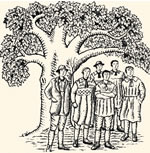
In 1856, when the granary was built in Sutton Waldron, Archdeacon Anthony Huxtable was rector of the parish. A conscientious and attentive priest, he was better known as a reforming farmer and member of the Chemical Committee of the Royal Agricultural Society, where he sat alongside scientists and agriculturists of international repute for over 20 years. He practised Scientific Farming on his two farms, seeing modern practice as the solution to the crisis in agriculture. His work on the manufacture and production of manures was significant in the development of modern farming techniques.
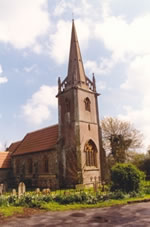
Huxtable did what he could to alleviate the problems of the agricultural labourers, giving work on his farms to the unemployed. In this he was somewhat unusual: at the time, the church was widely considered to be implicated in rural poverty.
In 1840 Huxtable married a local lady named Maria Langstone, and her considerable wealth made him a millionaire by today’s standards. He used this money to fund his ambitious scientific farming ideas, and also to fund the construction of the present village church – St. Bartholomew’s. Sir John Betjeman described it as "one of the best and most lovely examples of Victorian architecture”. The new church was completed in 1847. Whoever 'W.E' was, he/she would have known this church.
What was happening in the rest of England?
Captain Swing
The focus of the ‘Captain Swing’ riots in 1830 was the introduction of threshing machines on farms, threatening winter unemployment for arable farm workers.
Followers of ‘Captain Swing’ sent anonymous letters warning landowners and clergy of their intention to destroy machines and set fire to hayricks.
The movement began in Kent in June 1830, moved through Surrey and Sussex, and by November had reached Hampshire and Dorset.
In the Blackmore Vale not enough corn was grown to make this a real problem, but the threshing machines symbolised the injustices of rural life. Rioters destroyed machines, demanded money from farmers and attacked a constable.
In 1831 57 prisoners stood trial at Dorchester. Six of them were condemned to death but the sentences were transmuted and they were transported to Van Diemen’s Land (Tasmania) along with 18 other men from Dorset.
Tolpuddle Martyrs
Some 15 miles from Sutton Waldron, as the crow flies, is the village of Tolpuddle, famous as the home of the ‘Tolpuddle Martyrs’.
In March 1834 George Loveless and 5 other men were arrested for unlawful assembly, and charged with ‘administering unlawful oaths’. Their crime had been to meet and take an oath to demand a minimum wage for their labour. Under pressure from the government, the six men were sentenced to be transported to the penal colony in New South Wales, Australia. However, the men rapidly became popular heroes and in 1836 the government bowed to public pressure and remitted the sentences.
In 1934, on the centenary of the trial, the TUC (Trades Union Congress) founded the Tolpuddle Martyrs’ Museum in the village, and built six memorial cottages in memory of these pioneers of the trades union movement.
England in 1856
Victoria has been Queen of England for 19 years
* Lord Palmerston is elected as the British Prime Minister
* The Crimean war ends and Florence Nightingale returns as a heroine
* The Anglo-Chinese war begins
* The Victoria Cross is established to acknowledge bravery
* The Indian Mutiny is just beginning
Nearly 150 years later the moving of a granary brings this Victorian world back to life
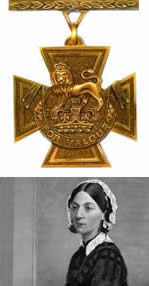
Moving the granary in 2005
In November 2005 the lifting and moving of the timber granary finally took place. This involved carefully inserting steel beams under the building, between the staddle stones to form a lifting frame.
The whole structure was then slowly lifted using the steel frame and a large mobile crane. Once in the air the building was gently manoeuvred onto a trailer.
It was then driven the short distance to its new location. The crane was used a second time to place it delicately and precisely onto its new staddle stones. Despite high winds and pouring rain the lift was completed successfully.
Now its conversion, under the guidance of the Conservation Management section, can begin. We hope it will still be standing in another 150 years.
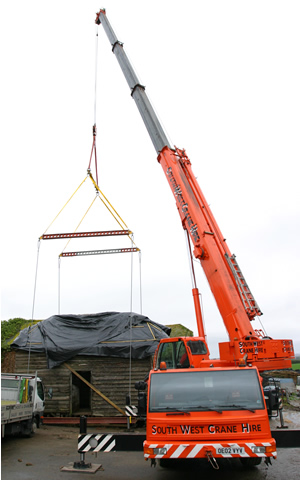 |
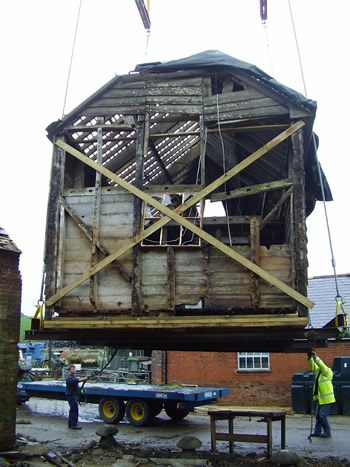 |
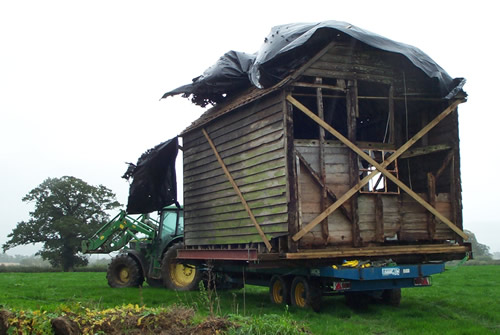 |
|
|
|
